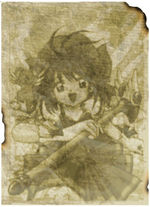User:Wehpudicabok/Anime
An anime is a chemical compound that contains the anime group, which consists of one oxygen atom, one tantalum atom, one potassium atom, and one uranium atom, with a total charge of negative one (OTaKU-). Anime compounds can be divided into two groups: animo acids and animo salts.
General properties of animes[edit | edit source]
Animes tend to be highly volatile and dangerous, even when diluted. Most animes are known to enlarge the eyes of anyone who ingests them, and many have other adverse effects, such as creating a popped vein in the drinker's right temple.
Addictive properties[edit | edit source]
Prolonged exposure to animes can result in serious anime addiction. A number of studies on the subject of anime addiction have shown that even so little exposure as looking at an anime can be enough to afflict some. Teenagers are particularly vulnerable to anime addiction; in laboratory conditions, teenagers are advised to keep away from any anime they see and to not experiment with any foreign-looking chemicals that could be animes.
Anime extraction process[edit | edit source]
Animes are very rarely found in their purest state. In most cases, they must be extracted from large, complex, solid compounds called manga. The process involves collecting the manga from manga deposits, submerging the compound in a sufficiently dissolving solvent (such as water), and refining the resulting anime. The refining phase is sometimes called "dubbing," due to the "dub-dub" sound the anime makes upon releasing impurities. During this stage, anime salts and acids are separated.
Anime extraction is a very delicate process, and improper care in the dissolution phase can lead to pure anime of remarkably low quality. Although some animes exist that are known for their successful dubbed solutions, most are considered to be far inferior to the original dissolved anime mineral, much less the original manga rock, especially in such areas as durability, luster, and keeping the words synced up to their freaking lips.
Anime naming conventions[edit | edit source]
Animes are named in a system radically unlike other chemicals. Most chemicals are named using a combination of their constituent ions or groups; however, animes are often named based on their physical characteristics, sometimes on their historical uses, and sometimes on a seemingly random sequence of words. This has led to a great deal of disagreement, conflict, and badly written hate mail among chemists, but the system is still the most common in use today.
Animo acids[edit | edit source]
Animo acids are the more reactive, violent, huge-sword-sporting type of animes. Most animo acids have the general structure H[M]OTaKU, where [M] is anything with a formal charge of zero. Exceptions include acids with a negative ionic component, such as tentacle animo acid (see below). These are called polyprotic animo acids; they contain multiple H+ ions, which usually end up as bad spinoffs or movies when dissolved in aqueous solution. Animo acids tend to be utilized by such chemists as ninjas, pirates, and shinigami.
Examples of animo acids[edit | edit source]
- Ninja animo acid – named so because it is often applied to ninjastars to make them deadlier.
- Pirate animo acid – named so because it is often applied to piratestars to make them deadlier.
- Alchemic animo acid – mentioned in old alchemical texts as having numerous transmutative properties, though its initial users warned of danger to one's arm associated with it if the exchange of atoms is not kept equivalent at all times.
- Animo acid on acid – the history behind its name is unknown, and frankly quite frightening.
- Tentacle animo acid – a strong animo acid which contains helium, nitrogen, tantalum, and iodine. It is one of the few naturally occurring animo acids; it is commonly found in the tentacles of octopi. It is sometimes called a "hentai" acid due to the formula of its negative ionic component, HeNTaI-. Although tentacle acid has little adverse affects on living beings, it dissolves clothes completely, especially schoolgirl uniforms.
Animo salts[edit | edit source]
Animo salts tend to be far less dangerous than animo acids, although they react just as easily. Most animo acids simply consist of the anime group coupled with any number of alkali metals, although some sport alkaline earth or even transition metals (these usually result in more bishōjo-ish salts, due to the increase in OTaKU- ions). Animo salts are typically sported by schoolchildren in love.
Examples of animo salts[edit | edit source]
- Sailor animo salt – though having nothing to do with sailors, this salt is a popular condiment among young girls, in large part due to an urban legend of "magical" properties.
- Fruity animo salt – this salt was formerly believed to be found in fruits and to have anthropomorphic properties.
- Love animo salt – a purported love potion when dissolved in aqueous solution. In reality, it just got members of the opposite gender to make fun of the drinker.
Animo base[edit | edit source]
- Main article: Bleach (base)
Bleach is the only known base to contain the anime group. It reacts completely with most animo acids and is considered a strong base despite lacking a chemical structure resembling any other strong bases. Most attribute this to its extreme amounts of spiritual energy.
In popular culture[edit | edit source]
Animes have a large cultural following, both inside and outside the chemical world. One of the largest examples of this is the phenomenon known as the anime convention, at which proponents of anime use gather to discuss anime-related topics, such as improvements on refining, popular use, effect on the global economy, and cosplay, or dressing up as one's favorite animo acid or salt. This latter subject, in fact, makes up the vast majority of anime convention activity; many anime followers, in fact, seem to have no business at conventions whatsoever aside from displaying their elaborate and time-consuming costumes before the only audience that will appreciate them.


